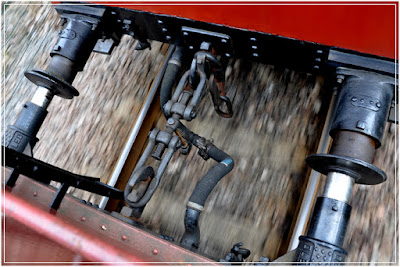Out and about on the Keighley and Worth Valley Railway on Saturday afternoon. The occasion was the rare running of two of the lines diesel shunters- originally the plan had been to ride the trains, but as things turned out we were in Shipley in the morning (more in the next blog), but after lunch at Oxenhope I (Ben) was dropped off to walk down the valley, back to the house, on a rare afternoon without The Childs.
After a run through the woods, I just managed to find a spot for the first Keighley-bound train with the shunters.
Having to back-track because of flooding, I managed a very low-angle shot (even by my standards) of the WD, 90733. The tree helping to disguise the classic 'Tupperware-lid sky' somewhat... Not bad, but something in the pollen hereabouts really kicked off my dormant hayfever, leading to much sniffing and sneezing.
And so on the walk down to Haworth, along the side of the derelict mill-race which once channeled water along the valley- it can be seen, in odd stretches, right along the main path.
A very nice lattice bridge over the abandoned mill race- shame the planking is starting to wear out.
Nice rusting detail on an ancient cast-iron kissing gate part way along the path.
Not too sure why I photographed this (particularly given the odd lighting), but I do rather like sheds.
Down to Ebor Lane just as the WD returns for Keighley. I wasn't expecting to get this spot to myself, as it is usually filled with photographers, or dog walkers, or gangs of teenagers, given my experience (particularly on a Saturday afternoon). A nice fallen bit of masonry means you can stand up and get an eye-level shot without trespassing.
A few minutes later, and chugging round the curve, came the shunters again. Luckily these engines are geared low, so moved slow enough for the D90 to cope (being as it really struggles in low light with moving targets).
So a little bit of history for the non-railway fraternity. These engines are known as Class 08's, and were built as the standardised shunting engine of British Railways, based on an older design of the London, Midland and Scottish Railway. Some of these locomotives are still in service on the main line railways, which is pretty good going for an engine built in the 1950's.
The leading locomotive is of particular note- bought recently by the railway, it has a cut-down superstructure because it originally ran on a mineral railway in South Wales, which had been built for much of the route along a drained canal, which consequently had very low bridges.
I'm a fan of these engine, both as a piece of industrial design, and simply as a nice machine, and have been since I was little- what can I say, the Devious 'Diesel' character from Thomas the Tank Engine was always a favourite.
Back on the walk, and some horses in a field nearby. Not a lot else to photograph on the walk, which was along a busy road.
But as fortune would have it, a good angle on the shunters again near Ingrow. The leading loco has been resident on the KWVR for many years, and I believe the intention was to replace it with the cut-cab new arrival because its mechanical parts were wearing out. But there seems to have been a change of heart, and it has been repainted into a 'modern' (well, 1990's) livery which really suits it.
So a nice walk and a chance for some railway photography. Shame about the weather, but hey-ho. Both engines were well turned-out, and a credit to the teams who've worked on them.
Coming next, trains again, but miniature ones this time, in Shipley...
























































